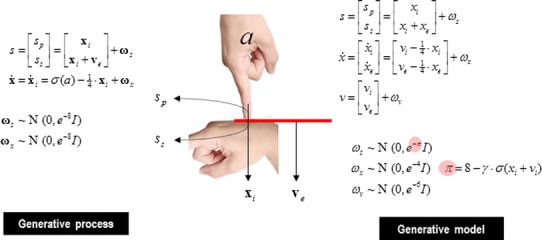Fig. 1.

Generative model: This figure shows the generative process and model used in these simulations. The generative process (left) models real-world states and causes, while the generative model (right) is used by the subject to make inferences about causes of its sensations. In the real world, the hidden state x i models self-generated forces that are sensed by both somatosensory s s and proprioceptive s p input channels. External forces are modelled with the hidden cause ν e and are sensed only by the somatosensory input channel. Action causes the self-generated force to increase and is modified by a sigmoid squashing function σ (a hyperbolic tangent function). The hidden state decays slowly over four time bins. In the generative model, causes of sensory data are divided into internal causes ν i and external causes ν e. The hidden cause excites dynamics in hidden states x i and x e which decay slowly over time as above. Internal force is perceived by both proprioceptive and somatosensory receptors, while external force is perceived only by somatosensory receptors. Crucially, the precision of the sensory prediction error π is influenced by the level of internal force, again modulated by a squashing function, and controlled by a parameter γ which governs the level of attenuation of precision. The pink circles highlight this state-dependent precision, which effectively controls the influence of sensory prediction errors during active inference
